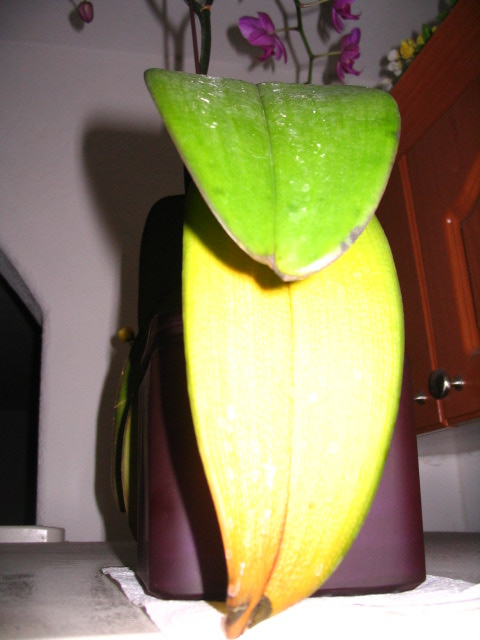Question
 OrchidLeaves
OrchidLeaves
Dear Wayne,
I'm sending you a pic of my orchid Dora. Isn't she's beautiful? She grows one or two flowers every other day or so. Dora lives in South FL, so I keep her mostly inside, near a window, and put her outside in the shade for one or two hours every other day. At night I place her near an A/C vent, where it's 75 degrees F or less. Not a bad life for Dora, huh?
My concern is that the leaf you can see in the bottom has turned pale/yellowish, and has developed a black spot in the tip. The leaf above it, has white stains in the center (it looks like a white powder), and a round small black spot. Is Dora sick or just missing some nutrients? Your help is greatly appreciated.
Sincerely,
Rick
AnswerRick, both the green leaf and the yellow one seem to indicate that sometime during the day the plant is exposed to too much light. The yellow leaf appears to be bleached from excessive light and, once overexposed, will not recover its previous green appearance. The next stage for this leaf is leaf drop so I wouldn't be concerned about the black spot. Both the light green color of the other leaf and the flowers also confirm the bright light. So you are experiencing the ying and yang of brighter light on phalaenopsis. They flower more profusely with brighter light but, just a little too bright, and the leaves can be stressed-- ultimately leading to cell death. I would recommend backing off the light intensity.
There is another explanation, however, which is less sanguine. If you purchased Dora within the past 6 months, she may be suffering from root rot. The only way for you to confirm this is to unpot the plant and check the roots. If roots are mushy and/or stringy, they can no longer provide the necessary nutrients to Dora. These should be removed before repotting ()healthy orchid roots are firm and turn green when wet). This results from a breakdown in the potting mix. If the potting mix consists of, or contains, moss, the moss may have compressed and kept the root zone too wet and/or restricted the flow of air through the potting mix. If there is no moss, the potting mix could still have decomposed-- having the same effect. If you elect to repot, use a commercially prepared orchid potting mix that has fir bark as its principal ingredient. It is generally recommended that orchids be repotted annually. Before using the new potting mix, strain out the finer particles and then soak the portion you plan to use . Repot to a plastic pot with at least 5-6 drainage holes. Water should flow freely through the pot. While the repotting could temporarily restrict growth pending the development of new roots and leaves- especially if there are few healthy roots remaining.
The white spots on the leaf may be mineral deposits. If your water is relatively free of mineraals, however, they may be mealy bugs. Soak a q-tip in some rubbing alcohol and see if they come off on the q-tip. The alcohol causes them to turn brown. Usually, however, mealies have a cottony appearance and differ considerably from mineral stains.






